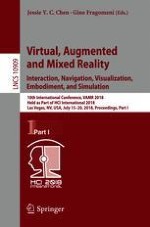2018 | Book
Virtual, Augmented and Mixed Reality: Interaction, Navigation, Visualization, Embodiment, and Simulation
10th International Conference, VAMR 2018, Held as Part of HCI International 2018, Las Vegas, NV, USA, July 15-20, 2018, Proceedings, Part I
Editors: Jessie Y.C. Chen, Gino Fragomeni
Publisher: Springer International Publishing
Book Series : Lecture Notes in Computer Science
